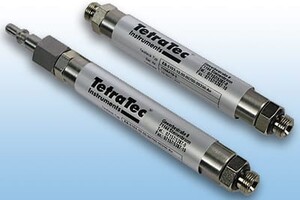Nozzle test leaks – series EB
Nozzle test leaks are used for the simulation of leakages during the adjustment or monitoring of leak testers or flow measuring devices. These test leaks are connected instead of a test sample or in parallel to a tight test sample for the measuring process.
The test leak series EB consists of a stainless steel tube, into which a micro nozzle or orifice is inserted. A filter protects the micro nozzle against contamination. Depending on the inlet pressure and the type of gas the orifice sets a defined flow. There is a distinction between critical and subcritical operation depending on the pressure ratio between inlet and outlet.

Product features include:
- Setting gauges and test leaks with orifices or nozzles
- Leakage rates of 2 Nml/min up to 10 Nl/min
- Inlet pressures of 0.01 up to 40 bar relative
- Manufacturing tolerance ±5 % up to ±10% of the nominal value
- Media compatibility: Air and inert gases
- Factory or DAkkS–DKD calibration certificate
- Calibration accuracy ±0.65% up to 1% of reading
Special features:
- Flow: Correction and conversion equations are indicated.
- Filter: Optional 4μm filter for small flows.
- Operational safety: Lower susceptibility for contamination compared with sinter leaks.
Note:
During critical operation the absolute inlet pressure is at least twice as high as the outlet pressure. The mass flow is approximately proportional to the present inlet density and the speed of sound of the medium.
During subcritical operation the absolute inlet pressure is less than twice of the outlet pressure. A mass flow is adjusted, which is proportional to the square root of the product of the differential pressure between inlet and outlet and the inlet density of the medium.
Nozzle test leaks
series EB
For simulation of leakages in leak tests
More information and technical details can be
found in the data sheet


